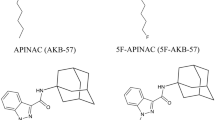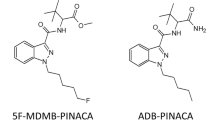Abstract
Purpose
Illegal use of synthetic cannabinoids (SCs) is a serious problem worldwide. Legal regulation of SCs requires fundamental analytical studies regarding the differentiation of potential structural isomers. Accumulation of SC metabolic profiles is also essential for forensic investigation because SCs are immediately metabolized after intake. Thus, we investigated the in vitro metabolism of N-adamantyl-1-(tetrahydropyran-4-ylmethyl)-1H-indazole-3-carboxamide isomers (ATHs) using human liver microsomes (HLMs). Moreover, we validated the applicability of the isomeric differentiation by investigation of N-adamantyl-1-(4-fluorobenzyl)-1H-indazole-3-carboxamide isomers (AFUs).
Methods
Metabolites were collected at designated time points during the incubation period with HLMs for up to 180 min. The structures of the metabolites were annotated on the basis of mass spectroscopic evidence obtained by liquid chromatography–ion trap–time of flight mass spectrometry.
Results
The secondary stage mass (MS2) spectra obtained from the protonated molecules revealed a clear difference in both ATHs and their major metabolites because of the stability of the adamantyl (AD) cation. In HLMs, ATHs were quickly metabolized, and hydroxylation of the AD ring was deduced as the major metabolic pathway. The major metabolites of ATH 1 and ATH 2 after 180 min showed dihydroxylation and monohydroxylation of the AD ring. The AFUs showed analytical and metabolic profiles similar to those of the ATHs described above.
Conclusions
We characterized the metabolism of ATHs for the first time and discriminated between the two isomers by mass spectrometric analysis of either the parent compounds or their major metabolites. Our investigation of AFUs also demonstrated a useful method for distinguishing between AD isomers.












Similar content being viewed by others
References
Diao X, Huestis MA (2017) Approaches, challenges, and advances in metabolism of new synthetic cannabinoids and identification of optimal urinary marker metabolites. Clin Pharmacol Ther 101:239–253. https://doi.org/10.1002/cpt.534
Underwood E (2015) A new drug war. Science 347:469–473
Diao X, Huestis MA (2019) New synthetic cannabinoids metabolism and strategies to best identify optimal marker metabolites. Front Chem 7:1–15. https://doi.org/10.3389/fchem.2019.00109
Gandhi AS, Zhu M, Pang S, Wohlfarth A, Scheidweiler KB, Liu HF, Huestis MA (2013) First characterization of AKB-48 metabolism, a novel synthetic cannabinoid, using human hepatocytes and high-resolution mass spectrometry. AAPS J 15:1091–1098. https://doi.org/10.1208/s12248-013-9516-0
Asada A, Doi T, Tagami T, Takeda A, Sawabe Y (2017) Isomeric discrimination of synthetic cannabinoids by GC-EI-MS: 1-adamantyl and 2-adamantyl isomers of N-adamantyl carboxamides. Drug Test Anal 9:378–388. https://doi.org/10.1002/dta.2124
European Monitoring Centre for Drugs and Drug Addiction (2016) EMCDDA-europol, 2015 annual report on the implementation of Council Decision 2005/387/JHA, implementation reports, Publications Office of the European Union, Luxembourg. http://www.emcdda.europa.eu/system/files/publications/2880/TDAS16001ENN.pdf. Accessed 7 Sept 2016
List of “Designated Substances” in Japan. https://www.mhlw.go.jp/content/11120000/000563116.pdf. Accessed 24 Nov 2019
Murakami T, Iwamuro Y, Ishimaru R, Chinaka S, Takayama N, Hasegawa H (2018) Differentiation of AB-FUBINACA and its five positional isomers using liquid chromatography–electrospray ionization-linear ion trap mass spectrometry and triple quadrupole mass spectrometry. Forensic Toxicol 36:351–358. https://doi.org/10.1007/s11419-018-0410-4
Diao X, Scheidweiler KB, Wohlfarth A, Zhu M, Pang S, Huestis MA (2016) Strategies to distinguish new synthetic cannabinoid FUBIMINA (BIM-2201) intake from its isomer THJ-2201: metabolism of FUBIMINA in human hepatocytes. Forensic Toxicol 34:256–267. https://doi.org/10.1007/s11419-016-0312-2
Vikingsson S, Josefsson M, Gréen H (2015) Identification of AKB-48 and 5F-AKB-48 metabolites in authentic human urine samples using human liver microsomes and time of flight mass spectrometry. J Anal Toxicol 39:426–435. https://doi.org/10.1093/jat/bkv045
Erratico C, Negreira N, Norouzizadeh H, Covaci A, Neels H, Maudens K, van Nuijs ALN (2015) In vitro and in vivo human metabolism of the synthetic cannabinoid AB-CHMINACA. Drug Test Anal 7:866–876. https://doi.org/10.1002/dta.1796
De Brabanter N, Esposito S, Tudela E, Lootens L, Meuleman P, Leroux-Roels G, Deventer K, Van Eenoo P (2013) In vivo and in vitro metabolism of the synthetic cannabinoid JWH-200. Rapid Commun Mass Spectrom 27:2115–2126. https://doi.org/10.1002/rcm.6673
Baranczewski P, Stańczak A, Sundberg K, Svensson R, Wallin Å, Jansson J, Garberg P, Postlind H (2006) Introduction to in vitro estimation of metabolic stability and drug interactions of new chemical entities in drug discovery and development. Pharmacol Rep 58:453–472
Holm NB, Pedersen AJ, Dalsgaard PW, Linnet K (2015) Metabolites of 5F-AKB-48, a synthetic cannabinoid receptor agonist, identified in human urine and liver microsomal preparations using liquid chromatography high-resolution mass spectrometry. Drug Test Anal 7:199–206. https://doi.org/10.1002/dta.1663
Takayama T, Suzuki M, Todoroki K, Inoue K, Min JZ, Kikura-Hanajiri R, Goda Y, Toyo’oka T (2014) UPLC/ESI-MS/MS-based determination of metabolism of several new illicit drugs, ADB-FUBINACA, AB-FUBINACA, AB-PINACA, QUPIC, 5F-QUPIC and α-PVT, by human liver microsome. Biomed Chromatogr 28:831–838. https://doi.org/10.1002/bmc.3155
Savchuk S, Appolonova S, Pechnikov A, Rizvanova L, Shestakova K, Tagliaro F (2017) In vivo metabolism of the new synthetic cannabinoid APINAC in rats by GC–MS and LC–QTOF-MS. Forensic Toxicol 35:359–368. https://doi.org/10.1007/s11419-017-0364-y
Kusano M, Zaitsu K, Yamanaka M, Hisatsune K, Asano T, Taki K, Hayashi Y, Tsuchihashi H, Ishii A (2016) Development of a mass spectrometric hydroxyl-position determination method for the hydroxyindole metabolites of JWH-018 by GC-MS/MS. J Mass Spectrom 51:350–357. https://doi.org/10.1002/jms.3761
Belal TS, Thaxton-Weissenfluh A, DeRuiter J, Smith F, Abiedalla Y, Abdel-Hay KM, Clark CR (2018) Differentiation of methylated indole ring regioisomers of JWH-007: GC–MS and GC–IR studies. Forensic Chem 7:1–9. https://doi.org/10.1016/j.forc.2017.11.001
Castaneto MS, Wohlfarth A, Pang S, Zhu M, Scheidweiler KB, Kronstrand R, Huestis MA (2015) Identification of AB-FUBINACA metabolites in human hepatocytes and urine using high-resolution mass spectrometry. Forensic Toxicol 33:295–310. https://doi.org/10.1007/s11419-015-0275-8
Andersson M, Diao X, Wohlfarth A, Scheidweiler KB, Huestis MA (2016) Metabolic profiling of new synthetic cannabinoids AMB and 5F-AMB by human hepatocyte and liver microsome incubations and high-resolution mass spectrometry. Rapid Commun Mass Spectrom 30:1067–1078. https://doi.org/10.1002/rcm.7538
Mardal M, Dalsgaard PW, Qi B, Mollerup CB, Annaert P, Linnet K (2018) Metabolism of the synthetic cannabinoids AMB-CHMICA and 5C-AKB48 in pooled human hepatocytes and rat hepatocytes analyzed by UHPLC-(IMS)-HR-MSE. J Chromatogr B: Anal Technol Biomed Life Sci 1083:189–197. https://doi.org/10.1016/j.jchromb.2018.03.016
Diao X, Wohlfarth A, Pang S, Scheidweiler KB, Huestis MA (2016) High-resolution mass spectrometry for characterizing the metabolism of synthetic cannabinoid THJ-018 and its 5-fluoro analog THJ-2201 after incubation in human hepatocytes. Clin Chem 62:157–169. https://doi.org/10.1373/clinchem.2015.243535
Vikingsson S, Gréen H, Brinkhagen L, Mukhtar S, Josefsson M (2016) Identification of AB-FUBINACA metabolites in authentic urine samples suitable as urinary markers of drug intake using liquid chromatography quadrupole tandem time of flight mass spectrometry. Drug Test Anal 8:950–956. https://doi.org/10.1002/dta.1896
Hwang J, Hwang J, Ganganna B, Song I, Heo MY, Ahn SH, Lee J (2018) Metabolic and pharmacokinetic characterization of a new synthetic cannabinoid APINAC in rats. Forensic Toxicol 36:88–101. https://doi.org/10.1007/s11419-017-0387-4
Holm NB, Nielsen LM, Linnet K (2015) CYP3A4 mediates oxidative metabolism of the synthetic cannabinoid AKB-48. AAPS J 17:1237–1245. https://doi.org/10.1208/s12248-015-9788-7
Rasul G, Olah GA, Prakash GKS (2004) Density functional theory study of adamantanediyl dications C10H142+ and protio-adamantyl dications C10H162+. Proc Natl Acad Sci 101:10868–10871. https://doi.org/10.1073/pnas.0404137101
Kevin RC, Lefever TW, Snyder RW, Patel PR, Fennell TR, Wiley JL, McGregor IS, Thomas BF (2017) In vitro and in vivo pharmacokinetics and metabolism of synthetic cannabinoids CUMYL-PICA and 5F-CUMYL-PICA. Forensic Toxicol 35:333–347. https://doi.org/10.1007/s11419-017-0361-1
Chauret N, Gauthier A, Nicoll-Griffith DA (1998) Effect of common organic solvents on in vitro cytochrome P450-mediated metabolic activities in human liver microsomes. Drug Metab Dispos 26:1–4
Drug Enforcement Administration, Department of Justice. (2019) Schedules of controlled substances: temporary placement of 5F-EDMB-PINACA, 5F-MDMB-PICA, FUB-AKB48, 5F-CUMYL-PINACA, and FUB-144 into Schedule I. Fed Regist 84:15505–15511. https://www.govinfo.gov/content/pkg/FR-2019-04-16/pdf/2019-07460.pdf. Accessed 16 Apr 2019
Hess C, Schoeder CT, Pillaiyar T, Madea B, Müller CE (2016) Pharmacological evaluation of synthetic cannabinoids identified as constituents of spice. Forensic Toxicol 34:329–343. https://doi.org/10.1007/s11419-016-0320-2
Diao X, Scheidweiler KB, Wohlfarth A, Pang S, Kronstrand R, Huestis MA (2016) In vitro and in vivo human metabolism of synthetic cannabinoids FDU-PB-22 and FUB-PB-22. AAPS J 18:455–464. https://doi.org/10.1208/s12248-016-9867-4
Acknowledgements
This study was funded by the Health and Labor Sciences Research Grants 2015–2017 and 2018–2020 to K. Kitaichi (Research on Regulatory Science of Pharmaceuticals and Medical Devices, No. 201523005A and 201824009A) and a grant-in-aid for Scientific Research to K. Kitaichi (No. 17K08417). A portion of this work was supported by the domestically programmed grant for the regional society from the Gifu Prefectural Research Institute for Health and Environmental Sciences. We also acknowledge the Gifu Regional Consortium on the Development of Analytical Procedures for Legal Highs operated by Gifu Pharmaceutical University and the Gifu Prefectural Research Institute for Health and Environmental Sciences for supervising the experimental protocols.
Author information
Authors and Affiliations
Corresponding authors
Ethics declarations
Conflict of interest
There are no financial or other relations that could lead to a conflict of interest.
Ethical approval
This article does not contain any studies with human participants or animals performed by any of the authors.
Additional information
Publisher's Note
Springer Nature remains neutral with regard to jurisdictional claims in published maps and institutional affiliations.
Electronic supplementary material
Below is the link to the electronic supplementary material.
Rights and permissions
About this article
Cite this article
Kadomura, N., Ito, T., Kawashima, H. et al. In vitro metabolic profiles of adamantyl positional isomers of synthetic cannabinoids. Forensic Toxicol 39, 26–44 (2021). https://doi.org/10.1007/s11419-020-00538-7
Received:
Accepted:
Published:
Issue Date:
DOI: https://doi.org/10.1007/s11419-020-00538-7




